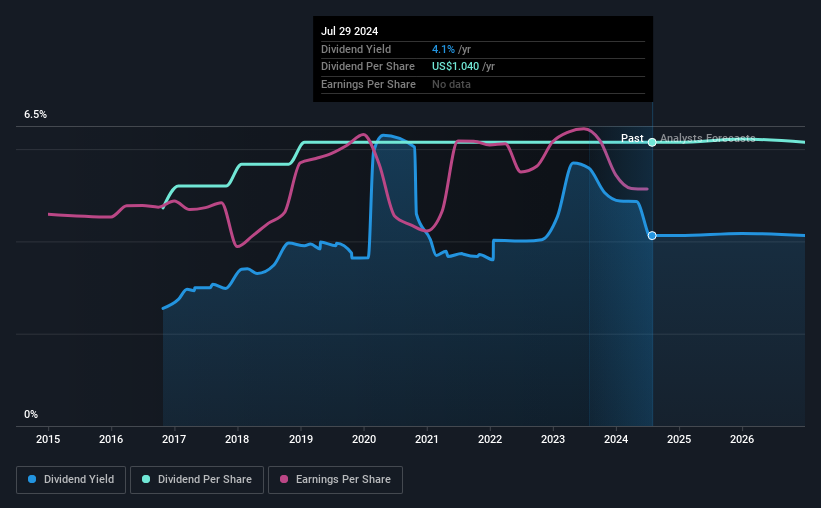
The board of First Hawaiian, Inc. (NASDAQ:FHB) has announced that it will pay a dividend of $0.26 per share on the 30th of August. Based on this payment, the dividend yield on the company's stock will be 4.1%, which is an attractive boost to shareholder returns.
Check out our latest analysis for First Hawaiian
First Hawaiian's Payment Expected To Have Solid Earnings Coverage
Impressive dividend yields are good, but this doesn't matter much if the payments can't be sustained.
Having paid out dividends for 8 years, First Hawaiian has a good history of paying out a part of its earnings to shareholders. Based on First Hawaiian's last earnings report, the payout ratio is at a decent 60%, meaning that the company is able to pay out its dividend with a bit of room to spare.
The next 3 years are set to see EPS grow by 5.0%. Analysts estimate the future payout ratio will be 60% over the same time period, which is in the range that makes us comfortable with the sustainability of the dividend.

First Hawaiian Is Still Building Its Track Record
First Hawaiian's dividend has been pretty stable for a little while now, but we will continue to be cautious until it has been demonstrated for a few more years. The dividend has gone from an annual total of $0.80 in 2016 to the most recent total annual payment of $1.04. This implies that the company grew its distributions at a yearly rate of about 3.3% over that duration. We like that the dividend hasn't been shrinking. However we're conscious that the company hasn't got an overly long track record of dividend payments yet, which makes us wary of relying on its dividend income.
Dividend Growth May Be Hard To Achieve
Investors could be attracted to the stock based on the quality of its payment history. Let's not jump to conclusions as things might not be as good as they appear on the surface. Over the past five years, it looks as though First Hawaiian's EPS has declined at around 2.8% a year. If the company is making less over time, it naturally follows that it will also have to pay out less in dividends. Earnings are forecast to grow over the next 12 months and if that happens we could still be a little bit cautious until it becomes a pattern.
In Summary
In summary, while it's good to see that the dividend hasn't been cut, we are a bit cautious about First Hawaiian's payments, as there could be some issues with sustaining them into the future. The company hasn't been paying a very consistent dividend over time, despite only paying out a small portion of earnings. We would probably look elsewhere for an income investment.
Companies possessing a stable dividend policy will likely enjoy greater investor interest than those suffering from a more inconsistent approach. Still, investors need to consider a host of other factors, apart from dividend payments, when analysing a company. As an example, we've identified 1 warning sign for First Hawaiian that you should be aware of before investing. Looking for more high-yielding dividend ideas? Try our collection of strong dividend payers.
New: AI Stock Screener & Alerts
Our new AI Stock Screener scans the market every day to uncover opportunities.
• Dividend Powerhouses (3%+ Yield)
• Undervalued Small Caps with Insider Buying
• High growth Tech and AI Companies
Or build your own from over 50 metrics.
Have feedback on this article? Concerned about the content? Get in touch with us directly. Alternatively, email editorial-team (at) simplywallst.com.
This article by Simply Wall St is general in nature. We provide commentary based on historical data and analyst forecasts only using an unbiased methodology and our articles are not intended to be financial advice. It does not constitute a recommendation to buy or sell any stock, and does not take account of your objectives, or your financial situation. We aim to bring you long-term focused analysis driven by fundamental data. Note that our analysis may not factor in the latest price-sensitive company announcements or qualitative material. Simply Wall St has no position in any stocks mentioned.
Have feedback on this article? Concerned about the content? Get in touch with us directly. Alternatively, email editorial-team@simplywallst.com
About NasdaqGS:FHB
First Hawaiian
Operates as a bank holding company for First Hawaiian Bank that provides a range of banking products and services to consumer and commercial customers in the United States.
Flawless balance sheet and fair value.
Market Insights
Community Narratives




